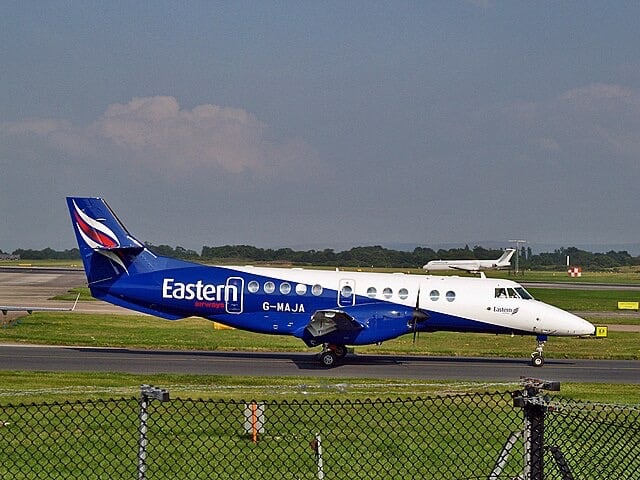Another European airline is on the brink of collapse, with Eastern Airways filing a notice of intention to appoint an administrator that gives the company just 10 days to resolve its financial crisis or go bust.
The regional carrier, which serves destinations across England and Scotland, now has until early November to fix its mounting problems before officially entering administration, potentially leaving hundreds of thousands of passengers facing cancelled flights.
Eastern Airways launched in 1997 and carries approximately 1.3 million passengers each year, playing a crucial role in providing regional air travel across the United Kingdom to communities with limited transport alternatives.
The airline currently operates services to destinations including Wick and Aberdeen in Scotland, as well as Humberside, Teesside International Airport, London Gatwick and Newquay in England.
Routes Previously Axed
However, Eastern Airways has struggled to maintain profitability across its network, previously operating numerous other routes that have since been cancelled due to financial pressures.
Services to Gibraltar from Southampton and Birmingham were launched in 2021 with considerable fanfare but were axed just 12 months later after failing to attract sufficient passenger numbers.
In March last year, the operator also cancelled its route between Cardiff and Paris Orly in France, representing another blow to regional connectivity.
Earlier this year, the airline announced it would be launching flights from Newquay in Cornwall to London Southend Airport in Essex, though this route cannot currently be seen on the airline’s website, suggesting it may have been quietly withdrawn.
Major Charter Provider
Eastern Airways has established itself as the number one provider of charter flights for sports teams across Europe, transporting Premier League and Championship football clubs, Rugby Union teams and Super League sides to away fixtures.
If the airline does go under, then all scheduled flights and charter services will be cancelled, potentially leaving major sports organisations scrambling to find alternative transport arrangements at short notice.
The loss of Eastern Airways would particularly impact smaller regional airports that rely heavily on the carrier’s services to maintain connectivity with major UK hubs.
Mounting Financial Losses
The company’s deteriorating financial position has been evident in recent annual accounts that show substantial and growing losses.
For the 12 months to March 2024, Eastern Airways reported a net loss of £19.7 million, representing an increase of £4.8 million compared to the previous year’s losses.
The company’s total debt rose by £4.8 million to £25.97 million, whilst profit fell sharply to just £454,000 from £1.55 million the year before, demonstrating the carrier’s struggle to generate sustainable revenues.
The Sun has contacted Eastern Airways for comment on the administration filing and what steps management is taking to secure the airline’s future.
Latest in Series of Airline Collapses
Eastern Airways is not the only carrier to face financial difficulties this year, with several airlines ceasing operations or filing for bankruptcy protection in recent months.
Last month, Play Airlines announced it would be ceasing operations with all flights being cancelled, leaving passengers who had booked with the Icelandic low-cost carrier facing disruption.
Play Airlines flew to numerous European destinations including London Stansted, Amsterdam, Paris and Faro in Portugal before its sudden collapse.
Last year, Spirit Airlines, a major US low-cost carrier, also filed for bankruptcy protection as it struggled with mounting debts and intense competition from larger rivals.
Historical Airline Failures
The UK aviation industry has witnessed several spectacular airline collapses in recent years that left hundreds of thousands of passengers stranded abroad.
Monarch Airlines ceased operations in 2017, which at the time represented the United Kingdom’s largest ever airline collapse, requiring a massive government-coordinated repatriation effort.
Thomas Cook then shut down in 2019 in an even larger failure that stranded 150,000 British holidaymakers overseas, though the brand has since been relaunched under new ownership without airline operations.
Impact on Regional Connectivity
The potential loss of Eastern Airways would represent a significant blow to regional air connectivity across the United Kingdom, particularly affecting Scotland and northern England.
Smaller airports such as Wick in the Scottish Highlands rely heavily on Eastern Airways services to maintain vital links with larger hubs, with few alternative transport options available in remote regions.
Business travellers and residents in these areas could face substantially longer journey times via road or rail if air services are withdrawn, potentially impacting economic development in already disadvantaged regions.
What Happens Next
The filing of a notice of intention to appoint an administrator provides Eastern Airways with a 10-day breathing space during which creditors cannot take enforcement action against the company.
During this period, management will attempt to secure emergency financing, negotiate with creditors or potentially find a buyer willing to rescue the airline and preserve services.
If these efforts fail, administrators will be formally appointed to take control of the company and either sell it as a going concern or wind down operations in an orderly fashion.
Passengers who have booked flights with Eastern Airways are advised to monitor the situation closely and check whether their bookings are protected under ATOL or credit card chargeback schemes.
In other airline news, TUI has recently axed flights to popular destinations from a major UK airport as part of network restructuring.
Meanwhile, a little-known airline is preparing to launch its first ever flights from a London airport, potentially filling some gaps left by carriers that have ceased operations.
Follow for more updates on Britannia Daily
Image Credit:
Eastern Airways G-MAJA – image by David Lunn, licensed under CC BY-SA 2.0, via Wikimedia Commons.



